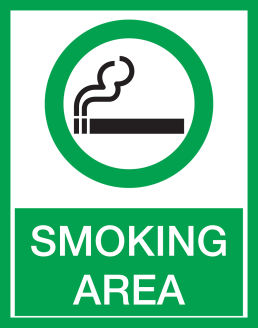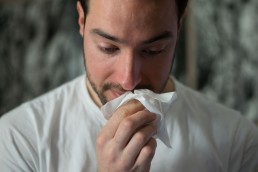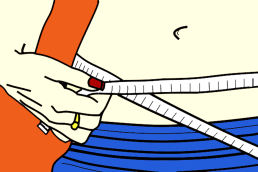The dilema of a smoker with COPD
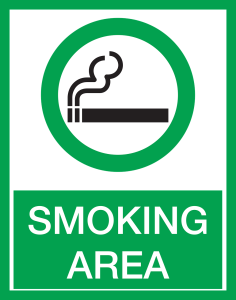 Smoking is a main contributing factor to developing COPD and there has been an ongoing debate as to whether Oxygen therapy should be prescribed to patients who are still smoking.
Smoking is a main contributing factor to developing COPD and there has been an ongoing debate as to whether Oxygen therapy should be prescribed to patients who are still smoking.
The reasons that oxygen might not be allowed are because in the presence of oxygen, things (like oxygen tubing, facial hair, clothing) are much more flammable and patients have set fire to their heads resulting in serious burns and occasionally even death.
Oxygen therapy is delivered through plastic tubes that go up the patients’ nostrils. Quite a lot of oxygen comes out of the nostrils and effectively bathes the face, head and clothing. Patients have set fire to themselves when not smoking, for example lighting stoves, and one patient was killed when an e-cigarette exploded.
The tubes that the oxygen goes through are made of PVC which is quite flammable and releases highly flammable vinyl chloride gas when it burns.
There is no safe way to smoke when using home oxygen. Until patients quit, they can practice safer smoking. Should an individual need to smoke, it’s important to first turn off the tank, and wait 10 full minutes before going outside to smoke. This practice should decrease the amount of oxygen in the home and on the person. The best way for patients to protect themselves, their families, neighbours, and emergency responders is to quit smoking.
Oxygen is a fundamental requirement for life and therefore taking away oxygen from a patient who will die without it is difficult and perhaps immoral, bringing into consideration other aspects of smoking.
Smokers quite often blame themselves for developing an illness where they are a burden on their families and often feel anxious, depressed and guilty. Oxygen therapy provides relief from some of the anxiety, but sadly effective psychological support is often lacking and oxygen is a kind of substitute.
The benefits from reducing smoking, such as fewer deaths and diseases of the heart and lungs can be discounted by 0% to offset the loss in pleasure that smokers suffer when they quit. For many smokers the fear of losing that pleasure from smoking and perhaps enjoying life a lot less is justifiable in perhaps dying sooner.
Patients are told not to smoke, but recent surveys show the percentage of home oxygen users still smoking to be between 14 and 51%. The use of a less combustible material for cannula tubing and a more efficient oxygen delivery system may reduce the incidence of such burns. Another suggestion would be labelling the oxygen cylinders with large stickers emphasizing the danger of smoking in the presence of oxygen.
In summary there are grave risks that COPD patients take if they smoke on oxygen therapy, such as a detrimental effect on health and disease progression and the risk of burns to themselves and others. However many find that oxygen therapy and the continuation of smoking improves their quality of life, both from the benefits of oxygen therapy and the pleasure obtained from smoking. There is a debate as to whether the importance of a patient's choice to choose how they live and die is outweighed by the possible risks and dangers to themselves and others.
References: http://abetternhs.wordpress.com
What has oxygen got to do with camping
 Fatalities have risen this summer and as there are still a few weeks remaining until the end of the season the government have been pushing preventative warnings out to all holiday makers. Deciding to go camping or to stay in a caravan sounds like a harmless and easily planned event. This is why it is popular with older people, as it is easy to travel to and any disabilities or medical conditions can usually be easily managed, especially with a caravan as it is basically just a smaller version of your own home. However there are a few things that must be remembered when doing so, otherwise your holiday could go disastrously wrong.
Fatalities have risen this summer and as there are still a few weeks remaining until the end of the season the government have been pushing preventative warnings out to all holiday makers. Deciding to go camping or to stay in a caravan sounds like a harmless and easily planned event. This is why it is popular with older people, as it is easy to travel to and any disabilities or medical conditions can usually be easily managed, especially with a caravan as it is basically just a smaller version of your own home. However there are a few things that must be remembered when doing so, otherwise your holiday could go disastrously wrong.
The main cause of fatalities has been due to carbon monoxide poisoning and related dangers. Carbon monoxide is a highly poisonous substance which is created when fossil fuels such as gas and solid fuels like charcoal and wood fail to combust fully due to a lack of oxygen. You can’t see it, taste it or smell it, but it can kill quickly with no warning.
This is usually caused by people cooking inside or allowing their BBQ’s to cool off inside the tent or caravan. When fuels are burning, the carbon monoxide being emitted is converted into relatively harmless carbon dioxide. But once the flame has gone out carbon monoxide continues to be produced and is no longer burnt off. The fumes build up in such an enclosed space quickly and many have died from inhaling carbon monoxide while they sleep. As carbon monoxide is inhaled, it enters the bloodstream and binds to the haemoglobin in red blood cells, replacing and blocking the oxygen molecules, which are normally attached. Your body is slowly starved of its oxygen as it cannot bind to the haemoglobin or travel into any tissues.
Another danger is from using open flame gas stoves, which if are not working properly or are left on can release harmful carbon monoxide. The open flames from a stove or BBQ also increase the risk to those that use oxygen as it is highly combustable and there have been incidences of explosions and severe burns where people have been cooking with their oxygen close by.
Make sure that tubing does'nt become tangled, equipment is secure and not used near open flames.
Oxygen therapy is the main treatment for carbon monoxide poisoning as the high concentration levels of oxygen basically forces displacement of the carbon monoxide molecules from the haemoglobin so that the oxygen can take its place. If you do start feeling any symptoms that could be carbon monoxide poisoning then having your oxygen close to hand could save your life. Some people keep their portable concentrator near to them when they sleep in case they awaken with breathing difficulties.
Barbeque safety
Never take a smouldering or lit BBQ into a tent, caravan or cabin. Even if you have finished cooking the BBQ should remain outside as it will still give off fumes for some hours after use
Never use a BBQ inside to keep you warm
Never leave a lit BBQ unattended or while sleeping
Place your cooking area well away from your tent. Always ensure there is an adequate supplyv of fresh air in the area where the BBQ is being used
Symptoms of CO poisoning include:
• headaches
• drowsiness
• dizziness
• chest pains
• nausea
• vomiting
At high levels, CO poisoning can cause:
• sudden collapse
• loss of consciousness
• death
It's not just BBQ season that you need to worry about CO poisoning, with winter around the corner many deaths occur from faulty boilers and open flames being used to help heat the home.
If you already have respiratory issues then even a small amount of carbon monoxide can greatly impact your oxygenation and breathing so ensure you have a monitor at home.
Carbon monoxide advice
Warning signs can include symptoms that disappear if you are away from your house, or which are worse in winter when the central heating is on more
Other people in the house, or pets, fall ill with similar symptoms
Clues to a leak can include black, sooty marks around gas fires, boilers or stoves
Smoke building up in rooms due to faulty flues
Do not sleep in a room that has an unflued gas fire or a paraffin heater
Make sure your kitchen has an extractor fan
Yellow instead of blue flames from gas appliances
To be safe, you should never use ovens or gas ranges to heat your home
Never use oversized pots on your gas stove, or place foil around the burners
Make sure rooms are well-ventilated and do not block air vents
References: www.bbc.co.uk/news/health and www.gov.uk
Colds and COPD
It's a depressing thought but autumn is just around the corner and with a change in weather there comes the increased chance of catching a cold. If you have COPD or emphysema then you probably already know how miserable it feels when you catch a cold as breathing is already a strain. Not only does catching a cold worsen your ability to breathe, but it also increases your chance of catching a more serious respiratory tract infection.
A cold is a viral respiratory illness, which normally affects your nose and throat but can affect your airways as well. A COPD patient already suffers from damaged airways and a cold will hinder your breathing further and cause other changes:
• An increase in phlegm
• An increase in the thickness or stickiness of the phlegm
• A change in phlegm colour to yellow or green
• The presence of blood in the phlegm
• An increase in the severity of shortness of breath, cough, or wheezing
• A general feeling of ill health
• Difficulty sleeping
• Increased fatigue
Respiratory infections are responsible for 70% of cases where a patient's COPD status has worsened. Catching a cold can open you up to a greater risk of developing more severe respiratory infections. Pneumonia is a common infection in COPD patients as the airways are obstructed and the body cannot cough up infected mucus.
Sometimes patients will require hospitalisation due to the worsening of their symptoms from a respiratory infection. It is important to always inform your doctor if your cold symptoms get worse and not wait until you have more serious breathing problems.
If you catch a cold then ensure you stay on your prescribed COPD medications and then decide, with your doctor, what else to take to treat the cold symptoms.
You might treat the body aches and fever associated with a cold with ibuprofen. Although antihistamines can be helpful if you have mild allergy symptoms, you should avoid them if you constantly have thick mucus; they may make it more difficult for you to cough up the phlegm.
Most over-the-counter cold remedies are generally safe for people with emphysema and chronic bronchitis. However, decongestants raise blood pressure and some of the drugs used to treat emphysema and chronic bronchitis can also increase your heart rate. Use cold remedies with caution, especially if you have high blood pressure or other heart issues in addition to COPD. Again, ask your doctor about medications for cold symptoms.
Patients who use supplemental oxygen should ensure their equipment is kept hygienically clean, especially when friends/family/carers come round who may have a cold or be the carrier of the cold virus. Some patients feel safer using their mask rather than their nasal cannula as it covers their nose and mouth to reduce the chance of breathing in germs. If you are trying to keep active then some use their masks and portable concentrators when going outside or when among crowds, not only to support breathing function but to protect from potential viral germs. Some patients also find that if they do feel cold symptoms coming on then using oxygen when they sleep overnight and using it more during the day helps prevent symptoms from worsening.
The best way to treat a cold is to prevent one, here are some general tips to help you avoid catching a cold:
• Wash your hands regularly.
• Avoid crowds during cold and flu season.
• Avoid cigarette smoke and air pollutants.
• Eat a balanced diet and exercise regularly.
• Stop smoking.
• Make sure you are using your inhalers correctly.
References: http://www.webmd.com
General benefits of oxygen
The benefits of oxygen can be felt by anyone, not just those suffering from a medical condition and requiring supplemental oxygen. We can all find easy ways to increase our oxygen levels naturally through breathing exercises, general exercise, getting more fresh air and eating a balanced diet of foods that help increase oxygenation in our blood.
The general benefits that oxygen brings to our body includes:
• Create energy
• Digest food
• Eliminate toxins from the body
• Fuel the body muscles
• Metabolize fat and carbohydrates
• Increased clarity
• Transport gases across cell membranes
• Strengthen our immune system
• Manufacture hormones and proteins
• Remove viruses, parasites and harmful bacteria
• Keeps the heart pumping and healthy
• Incites the lungs to breathe
• Allow the nerve system, and all other body tissues to function normally
Increasing your oxygenation levels and being fit and healthy has shown to be important for your health as optimum oxygen levels can improve wound healing, vision, mental clarity and intelligence, boost your immune system, help fight cancer cells, reduce stress levels, improve your heart and respiration and help you to lose weight.
For those people who use supplemental oxygen at home there are also long-term benefits:
• Prolongs life by reducing heart strain
• Decreases shortness of breath
• Makes exercise more tolerable
• Results in fewer days of hospitalization
• Improves sleeping
• Improves quality of life
Additional Benefits of Oxygen:
With increased oxygen levels the red blood cells can become fully saturated to provide their maximum potential of oxygen to our cells. Waste gases and toxins are removed more efficiently and cells can perform optimally. Many viruses and bacteria are anaerobic and cannot survive in oxygenated conditions. Oxygen can help build persistence to infections as it not only boosts the immune system but prevents anaerobic organisms from thriving. Oxygen also helps to neutralise acids such as lactate acid which builds up from high-working muscles. It improves wound healing by generating capillaries to grow into the wound to provide blood flow and oxygen to the injured cells to boost regeneration. It generally boosts all chemical pathways in our body and we can burn more fat. We feel better, our body is healthier and we think more clearly because of increased oxygenation.
Recent research has also discovered other benefits:
• Removes free radicals
• Reduces tissue swelling
• Increases energy metabolism in the brain
• Can create sustained cognitive improvement
• Wakes up idling brain cells that are metabolising enough to stay alive but are not actively ‘firing’
• Deactivates toxins and poisons (e.g. side effects from some chemotherapy, spider bites, air pollution, etc.)
• Enhances wound healing (stimulates new capillaries into wounds)
• Acts as an anti-inflammatory
Oxygen is required for nearly every mechanism within our body and by ensuring your body has the optimal levels of oxygen will improve your general medical health and well-being.
Too much oxygen however has a negative impact on our health which is why supplemental oxygen needs to be prescribed and regulated by a doctor to ensure that no oxidative stress occurs on the body which could lead to heart and respiration problems and necrosis.
References: http://www.bodydesigncenter.com
Anxiety
Many people who suffer from COPD also struggle with anxiety. When you have trouble breathing your brain triggers a response to warn you that something is wrong which can cause panic and sensations of anxiety. Also people find they suffer anxiety due to worrying and being stressed about the condition and prognosis as the disease worsens as well as being linked to depression which many COPD patient's suffer from. Medications used to treat COPD can also trigger anxiety too.
The Breathlessness-Anxiety Cycle
It is often a vicious cycle where feeling breathless can cause panic and anxiety, which in turn makes it more difficult to breathe. This cycle can be difficult to break and the symptoms of COPD become indistinguishable from the symptoms of anxiety. Many are confused and make lots of trips to the doctors. Many people avoid enjoying social and leisure activities that can cause breathlessness out of fear from potentially experiencing anxiety that may be caused.
Having some degree of anxiety when you have a chronic disease can be a good thing. It can make you pay attention to your symptoms and follow your treatment plan. It can also warn you when you need to seek medical attention, but too much anxiety can severely impact the quality of your life.
Coping With Anxiety
Coping with anxiety can be tricky especially as many medications have a negative impact on your health if you are suffering with COPD as they can cause decreased rate of breathing and interact with other COPD medications.
Your doctor can help you to determine what medication will work best for you. Some people with COPD find relief with non-addictive anti-anxiety medications which don't interfere with breathing.
Medications are helpful but their effectiveness will be increased by other means of reducing anxiety. Ask your doctor about referral to a pulmonary rehabilitation program, where you will receive education about COPD and get help with coping strategies to deal with your anxiety. One of the most important things that you learn in pulmonary rehabilitation is how to breathe more effectively.
Breathing Retraining
Breathing techniques such as “pursed lip breathing” can help to take the work out of breathing, slow your breathing down, keep your airway open for longer—and help you to relax. To do pursed lip breathing, you simply relax your upper body, and then breathe in slowly through your nose to the count of two. Then with lips pursed as if you were going to whistle, you breathe out slowly through your mouth to the count of four.
Counseling/Therapy
Many people with COPD find that individual counselling is effective in reducing anxiety. One common type of therapy called cognitive behavioural therapy helps people with anxiety symptoms decrease them through learning relaxation techniques and breathing exercises.
Group counselling, such as support groups can also help you to learn how to cope with COPD – and your anxiety – and being with others who have some of the same problems can help you to feel less alone.
Home Oxygen
Many find that if they are in the breathlessness/anxiety cycle then by immediately treating the breathlessness can instantly lessen the feelings of anxiety. By having a portable oxygen concentrator you have access to your oxygen wherever you are, whatever you're doing and if needed can use it when you are feeling short of breath. Knowing that you have the portable concentrator to hand can also in itself reduce your anxiety levels and help prevent episodes as you have that security and peace of mind that if your anxiety or COPD symptoms suddenly flare up that you have something close to hand to instantly resolve it.
References: http://www.healthline.com
Body weight and COPD
Malnutrition can be a common complication with COPD. This is due to dyspnea, a major symptom of COPD, which makes people feel like they have no appetite. People with COPD require 10 times as many calories as healthy people in order to breathe. A patient may suffer dyspnea, have no appetite and not eat enough. They then cannot get enough energy from their food intake to breathe sufficiently and they can then feel tired and their dyspnea increases, making it a vicious circle. The best way for someone to supplement calories without having to eat more to do so, is to eat foods that are higher in calories. This is just one reason why COPD patient's need to be careful of their diet.
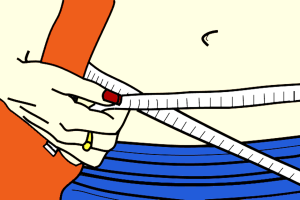 Finding the right diet should be part of your management plan for COPD. A healthy diet can help people with COPD maintain an optimal weight and keep COPD symptoms in check, and it provides the much needed energy. The trick is eating right to avoid shortness of breath during meals.
Finding the right diet should be part of your management plan for COPD. A healthy diet can help people with COPD maintain an optimal weight and keep COPD symptoms in check, and it provides the much needed energy. The trick is eating right to avoid shortness of breath during meals.
COPD: The Impact of Body Weight
Maintaining a healthy weight is very important in order to control your symptoms but being underweight is just as a bad as being overweight.
If you are overweight then carrying more weight around can increase shortness of breath. One factor that may contribute to the problem is the inflammation associated with fat tissue. But excess fat may also constrict the lungs, making it harder to breathe. The weight of the fat on the chest wall decreases the amount of room for the lungs. It also pushes up on the diaphragm, restricting its movement, particularly when bending over or lying down.
Being underweight however is potentially worse as being underweight and weaker will zap your energy, make it more difficult to breathe as your muscles are weaker and give you a poorer prognosis in the long-term.
COPD: Nutrition Tips
A doctor or nutritionist can help you to work out the plan to suit your medical requirements.
• Monitor calories: If you are overweight, you can lose weight by eating fewer calories. But don't eat so few calories that you feel fatigued and hungry all of the time.
• Avoid fad diets: COPD patients need to eat a healthful, balanced diet instead of going on fad diets to control weight.
• Focus on protein: Ensure you're eating enough protein as protein is particularly important for COPD patients who are exercising as part of their pulmonary rehabilitation plan.
• Watch your portions: COPD patients usually find it better to eat small meals frequently rather than large meals twice a day as it helps lessen shortness of breath.
• Get balanced: Focus on consuming fruits, vegetables, dairy products, whole grains, and lean proteins.
• Limit salt: Consuming excessive sodium can lead to fluid retention, which can worsen your shortness of breath.
• Remember your oxygen: If your doctor recommends it, use supplemental oxygen during and after meals to aid in digestion and help combat any periods of shortness of breath.
Ensuring you have a healthy diet is extremely important, not just in the types of food that you eat but the amount and frequency that you eat. The right plan can help manage your symptoms, improve quality of life, provide you with energy and help your body fight against infection. With COPD you need more energy to breathe so feed your body well.
References: www.everydayhealth.com and www.copd.about.com and www.health.com
Seperating myths from truth
COPD is often misunderstood as the symptoms can be caused by different types of lung diseases. Separating the fact from the fiction will help you to understand your condition and help you to liver better and manage your COPD.
COPD is an umbrella term for Emphysema, Chronic Bronchitis and Chronic Asthmatic Bronchitis but all three result in obstructed air flow through the lungs.
Common misunderstandings include that it only occurs in older smokers and that nothing can be done about it. Here are four common misconceptions and the truth about them:
Myth or Truth: Only Smokers Get COPD
Long-term smokers do commonly suffer from COPD symptoms such as cough, shortness of breath and frequent lung infections. Whilst COPD is normally caused by smoking, this isn’t true for everyone and in different parts of the world it may be more commonly caused by wood smoke from cooking fires. Other causes include:
• Progressive forms of asthma
• Being born without a protein called alpa-1 antitrypsin
• Workplace exposure to gases and fumes
• Heavy exposure to second-hand smoke or air pollution
Myth or Truth: COPD Only Occurs in Older People
COPD is more common in older people who have smoked for many years. However younger people can develop COPD and a lung test can detect early changes and provide early detection. Even before COPD symptoms develop, the early changes of emphysema or bronchitis may be present and COPD can be diagnosed in people as young as 30.
Myth or Truth: People With COPD Need to Slow Down
COPD symptoms may make some types of activity difficult, but slowing down is not good for those with COPD. Physical therapy, including breathing exercises and exercises to strengthen the arms and shoulders, can be an important part of treatment. Regular exercise along with a healthy diet helps muscles stay strong, and that reduces the demand placed on the lungs.
People with COPD should also try to stay active socially. Isolating yourself at home can lead to depression, which can make symptoms worse. It is important to stay in touch with friends and family and maintain a good support network. Many people with COPD also benefit from participating in support groups.
The correct use of supplemental oxygen at home can make life a lot easier, especially with the use of portable concentrators so that you can still go out and exercise and do daily activities whilst still using oxygen. There are different types of equipment and accessories that the oxygen supplier can provide to help improve your quality of life so that you don’t have to slow down.
Myth or Truth: There Is No Treatment for COPD
This is the biggest myth about COPD - that you can't do anything about it. Although there is no cure for COPD, it can be treated and managed in many people. It does depend upon how advanced the disease is and whether you are suffering from any other possibly complicating diseases such as hypertension, heart disease or diabetes. You can slow down the progression of COPD by:
• Taking medication as directed
• Getting pulmonary rehabilitation
• Using oxygen as needed
• Stopping smoking
With these changes, many people are able to manage their COPD symptoms well. If you smoke, even if you are still in your 30s, ask your doctor to check your lung capacity. It’s never too late to quit as when you do, your lung capacity immediately begins to improve, however there may have been some irreversible changes to your lungs already if early stages of COPD have already set in. Many of the irreversible effects of chronic bronchitis, emphysema, and chronic asthmatic bronchitis can be avoided with early diagnosis and treatment.
References: www.everydayhealth.com
Using nature to improve your health
 It has been discovered just how good certain fruit and vegetables are for you and some have properties which could aid people with respiratory problems and can help improve oxygenation of your body. Supplemental oxygen can provide you with additional oxygen, which in itself has many health benefits but you can supplement this by improving your diet. By adding vegetables high in nitrates or lemon juice to your diet you can improve oxygen levels in your body, breathe easier and be able to get around and exercise a lot better, fundamental for suffers of conditions like COPD.
It has been discovered just how good certain fruit and vegetables are for you and some have properties which could aid people with respiratory problems and can help improve oxygenation of your body. Supplemental oxygen can provide you with additional oxygen, which in itself has many health benefits but you can supplement this by improving your diet. By adding vegetables high in nitrates or lemon juice to your diet you can improve oxygen levels in your body, breathe easier and be able to get around and exercise a lot better, fundamental for suffers of conditions like COPD.
Beetroot:
Beetroot juice contains nitrates which help widen the blood vessels, increasing blood flow and allowing more oxygen to be delivered to the cells that need it and if you drink a glass a day it can help reduce blood pressure by 7%.
It can allow you to exercise for longer as it can deliver more oxygen to the muscles. As well as reducing the workload on the heart and make the heart consume less oxygen during exercise. The exercise itself becomes more effective and you can exercise for longer before becoming fatigued. It was found that you could cycle 16% longer from just 500ml Beetroot juice a day for 2 weeks.
Nitrate also triggers a series of chemical reactions in the blood which can increase oxygen in areas of the body which are lacking an oxygen supply.
Celery, cabbage, spinach and lettuce are also high in nitrates and have similar findings.
Lemons:
Lemons are full of negatively charged ions which increase the flow of oxygen to the brain. This can make us feel more alert, less drowsy and improve our mental activity, as well as protect us from germs in the air.
Drinking lemon juice has been shown to help against heartburn, bloating and belching. Your bowels can eliminate waste more effectively and constipation and diarrhoea can be prevented.
Lemon can also stimulate the liver and help dissolve poisons and toxins. In addition, the high content of potassium in lemons can help nourish nerve cells and brain function.
Lemon juice can help people with a wide variety of health conditions, such as, asthma, colds, coughs, sore throat, diphtheria, influenza, heartburn, liver problems, scurvy, fevers and rheumatism.
Lemon can help increase oxygen levels in the body as the juice will help adjust oxygen and calcium levels by regulating the carbohydrate levels which affect blood oxygen levels.
Some simple remedies include: For a sore throat, dilute one-half lemon juice with water and gargle often throughout the day. A slice of lemon bound over a pus formation – on a joint – will bring everything to the surface and be removed. And, for asthma patients, a tablespoon of lemon juice – one hour before eating will greatly assist in digestion and help to reduce your symptoms.
References: www.dailymail.co.uk and www.naturalhealth365.com
Oxygen and brain damage
Most of us are aware that a lack of oxygen to the brain results in brain damage. However many do not realise that even low levels or a small period of time of oxygen starvation can cause brain damage.
• Even though the brain makes up only 2 percent of the average person’s body weight, it consumes 20 percent of its oxygen.
• For every minute that the body goes without breathing, the risk of permanent brain damage increases greatly.
• After 5 minutes without oxygen, brain cells begin to die off.
Some lung conditions greatly affect the amount of oxygen that the lungs can absorb from the air we breathe and with low oxygen levels it can lead to the brain being slowly deprived of oxygen and possibly result in minor or major brain damage. Early symptoms of this can be chronic headaches, hypertension or even a heart attack or stroke. Over time there may only be small changes such as memory loss, confusion, difficulty in walking etc. or more major changes such as blindness, personality changes, speech/communication problems or a reduced ability to think flexibly, work through problems or be able to learn new things.
Sleep Apnea is also a worrying condition, which many people with lung conditions suffer from as during the night you can stop breathing for periods of time, even though maybe only for a short while. However each time it happens the chance of oxygen deprivation to the brain greatly increases and also the risk of brain damage. If you feel that you may be suffering from this condition then visit your doctor and you may be prescribed oxygen to have at night to increase your oxygen levels while you sleep.
For those patients using home oxygen therapy it is very important to ensure that the equipment is working correctly and that the flow rate of the oxygen being supplied by the machine is also correct. It may be only slightly out and not make a noticeable difference to your breathing, however even a slight lowering of oxygen levels over time, if left unchecked, may result in poor health implications on your organs, general health and your brain function, especially if there are other health problems you suffer with that may impact upon your oxygen levels. This is why it is important to visit your doctor regularly and be monitored as well as to check your equipment at home on a regular basis. Discuss with your doctor or equipment provider about alternative equipment or other accessories or indeed other easy natural ways that you can ensure your oxygen levels remain as high as possible during day and night.
References: http://lunginstitute.com and http://www.braininjury-explanation.com
10 WAYS TO HELP INCREASE OXYGEN LEVELS
Using supplemental oxygen will increase your oxygen levels but there are other tips that can help increase your oxygen levels, its circulation and your body's ability to take up the additional oxygen and utilise it more efficiently. Take a look at these ideas as in conjunction with your home oxygen therapy a little change could greatly increase your oxygen levels and quality of life.
These 10 ideas will help to improve your oxygen levels:
1. Open your windows. Fresh air will bring additional oxygen into your home and even if you are constantly breathing in oxygen through a cannula, whenever you talk or open your mouth fresh air containing higher oxygen levels can be drawn into your body. If you live in a smoggy area then you could consider investing in an air-filtration system.
2. Plants. They are the opposite of us as they take-in carbon dioxide and expel oxygen. Thereby increasing the foliage and plants in your home will decrease the carbon dioxide and increase the oxygen levels in your home.
3. Aroma. Many of the chemical-filled candles and various other incense type products actually contain carcinogens. Instead it is better to burn all-natural beeswax candles as then you’ll have better luck breathing in oxygen.
4. Exercise. Even a small amount of exercise will help to improve your respiration ability, as your breathing rate increases and deepens your lungs can absorb more oxygen.
5. Increase your water intake. Water is made up of oxygen so by increasing your water consumption you can increase the amount of oxygen in your body.
6. Go Green. Eating more fresh, raw green juices is beneficial as they are full of vitamins and minerals which your body utilises to aid in the uptake of oxygen.
7. Meditation. Daily meditation or just simply sitting quietly and focusing on your breathing and taking deep breaths for a few minutes can greatly help in reducing stress and improving your oxygen intake.
8. Eat lron-rich foods. Your diet can seriously impact your oxygen levels. Certain foods can help improve your oxygen levels in the blood naturally. Target iron-rich foods such as meats, poultry, fish, legumes and green leafy vegetables as they can improve iron deficiency, which in turn improves blood oxygen levels.
9. Cut out Salt. A diet low in sodium can lead to increased oxygenation via the kidney and the blood.
10. Eat green raw foods. Oxygen-rich foods can naturally increase your blood oxygen levels. Try eating more green vegetables like kale, broccoli and celery in order to boost your oxygen levels and hopefully breathe easier.
References: http://lunginstitute.com

